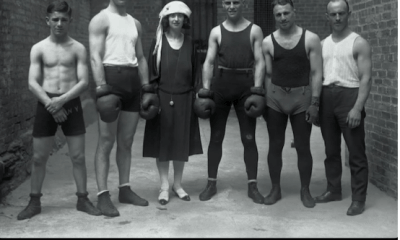Canada and USA
On The Road With Sonny Liston; a Flashback With Lem Banker
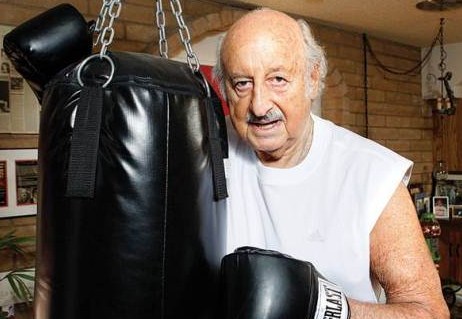
In late June of 1970, Sonny Liston ventured to New Jersey where he dismantled Chuck Wepner in nine gory rounds. For this assignment, the former heavyweight champion was paid in cash. But when Liston returned to Las Vegas, every cent of it was gone. Lem Banker knows the story. Banker was in Liston’s traveling party.
Banker was one of three people who accompanied Liston on this excursion. The others were Davey Pearl and Johnny Tocco. Only Banker (pictured at his home in 2009) is still living. He turned 90 on May 4.
Davey Pearl, who died at age 88 in 2006, was Liston’s manager of the moment. A hotel bellman during his early years in Las Vegas, Pearl was short of stature but very nimble; he was a former handball champion. In time he would become, however briefly, Nevada’s most prominent boxing referee. His signature fight was the 1981 classic between Sugar Ray Leonard and Tommy Hearns.
Johnny Tocco was Liston’s trainer. A boxing lifer who was a spit bucket carrier while still a growing boy, Tocco came to Las Vegas from St. Louis in 1953 and opened the Ringside Gym, perhaps the last of the great old boxing gyms still standing. Tocco died in 1997, but subsequent owners have kept his spirit alive (which is to say that the bare-bones gym, which ought to be on the National Register of Historic Places, is as grungy, as dark and as poorly ventilated as it ever was).
Lem Banker was pals with all three. A South Jersey native, he went along for the ride.
Liston vs. Wepner was staged in an armory in Jersey City on June 29, a Monday. Liston was then banned from fighting in New York because of his alleged ties to underworld characters, so taking it across the river to Madison Square Garden was out. Tickets were priced at $5, $10, and $15.
The Liston party stayed in a hotel in nearby North Bergen. Mickey Duff, the great British boxing promoter, was there too. Duff was then managing the affairs of rising heavyweight contender Joe Bugner who had signed on as one of Chuck Wepner’s sparring partners and would be Wepner’s next opponent after he had been butchered by Liston in what would prove to be Liston’s final fight.
“The first thing that Duff told us was ‘don’t drink the water,’” recalls Banker. It wasn’t because it didn’t taste good; the intimation was that someone, if accorded the chance, would tamper with it. That dictated a run to the supermarket for bottled water, a commodity fairly uncommon in 1970.
A shade more than five years had elapsed since Liston’s infamous rematch with Muhammad Ali, the bout where he was felled by a phantom punch. He was 14-1 since that fateful day in Maine, a stretch that began with four fights in Sweden. But the “L” had come in his most recent fight where he was flattened by former sparring partner Leotis Martin and it was widely assumed that he was older than 38, the age indicated by his driver’s license.
Notwithstanding these factors, Liston was favored to beat Wepner whose regular job was that of a traveling salesman for a liquor distributor. Wepner had a decent record (23-5-2 said the papers, a fair approximation) and would have the crowd in his corner, but he was regarded as little more than a journeyman.
Chuck Wepner had already acquired his cognomen: The Bayonne Bleeder. Sonny Liston embellished it. The claret started flowing in round two when Wepner’s nose began leaking.
During the fight, the ring doctor attempted to visit Wepner’s corner after the third round and again after the sixth. Both times he was turned back by Abe J. Greene, who wore two hats as the head of the New Jersey Athletic Commission and the head of the World Boxing Association. Finally, after the ninth round, the doctor was given the green light to give Wepner a good look-over.
Wepner was controlled by Al Braverman, a jack-of-all-trades who was equally comfortable as a promoter, manager, booking agent, trainer or cut man. Twelve years earlier, the Runyonesque Braverman had his Massachusetts boxing promoter’s license revoked for knowingly allowing boxers to borrow the names of fighters who were overseas in the Armed Forces. He would go on to become Don King’s right hand man.
When the ring doctor entered Wepner’s corner after the ninth round, Braverman protested. “Jeez, don’t stop it now,” he said, “We only have one round to go. Can’t you see that all these cuts are superficial?”
The doctor was un-persuaded. Those “superficial” cuts eventually required 72 stitches.
For the record, Liston was ahead 6-2-1 on the scorecard of referee Barney Felix through the nine completed rounds. Felix was the sole arbiter. In the Garden State, judges were only used for world title fights, a rarity before gambling casinos arrived in Atlantic City.
Liston’s purse was $13,000 (roughly $80,000 in today’s dollars). Promoter Willie Gilzenburg, says Banker, handed the money to Liston in a brown paper bag. The money was parceled out on the flight home, leaving Sonny with nothing. Banker got $10,000, payment for a debt. Pearl and Tocco split what was left.
Twelve days before Liston fought Wepner, Jerry Quarry opposed Mac Foster at Madison Square Garden. A 27-year-old ex-Marine, Foster was supposedly the next big thing. He had knocked out all 24 of his opponents. Liston was smitten with him; Sonny didn’t see how Foster could possibly lose. But Foster was too green for the battle-tested Quarry who knocked him out in the sixth round.
“Sonny asked me to bet $10,000 for him on Foster,” recollects Banker. This was out of character for Liston, a frugal man. He was occasionally seen hunched over a craps table, but betting on sports — boxing or team sports — wasn’t his bag. But he was obsessed with getting down a big bet on Mac Foster and beseeched Banker to handle it. Who better than Lem Banker to serve as his proxy? Lem had contacts all over the country. He could ferret out the best price.
LEM BANKER
Lem Banker inherited his love of boxing from his father who was a great admirer of Sam Langford, the legendary Boston Tar Baby. During his high school days in Union City, Lem frequently hung around the boxing gym run by Joe Jeannette, another of the great “chitlin’ circuit” fighters from Sam Langford’s era. Jeannette showed Banker his scrapbooks and encouraged young Banker, a good athlete, to keep scrapbooks of his own.
Banker’s dad, the son of Russian immigrants, owned what folks back east called a candy store. There was candy for sale, none of it made in-house, and comic books and whatnot and a lunch counter where folks ordering from the limited menu were partial to ice cream sodas. It was also a place where a man could surreptitiously get down a bet, which in those days invariably meant a bet on a horse race.
Coming out of high school, Lem fielded offers to play basketball from national powers St. John’s and Long Island University, but Uncle Sam had other ideas and Lem spent two years in the Army. He had several matches against other servicemen while stationed in Yokohama. A Xeroxed sheet in one of his scrapbooks informs us that he knocked out one Kadia Massey from Durbin, North Carolina, in the first round.
“I had another fight when I was stationed over there where it was me that got knocked out in the first round. I didn’t save that sheet,” he says sheepishly.
Banker eventually enrolled at the University of Miami, but left school after getting into a beef with the basketball coach. He returned to the New York metroplex where his acumen as a sports handicapper made him a certified wiseguy. (In sports gambling lingo, a “wiseguy” is a fellow with a sharp opinion and deep pockets.)
In 1957, Lem moved to Las Vegas. His girlfriend Delores “Debbie” Vicario soon joined him. They were married in 1959 and had one child, a daughter, Blaine.
Debbie was a former beauty pageant winner and showgirl. She was working in a floor show at the Riviera in Havana when Fidel Castro’s rebels came down from the hills and captured the city. “The show’s producer,” recalls Banker, “ordered up three blondes, three brunettes, and three redheads.” Debbie was a natural redhead.
In 1967, Lem and Debbie purchased a hacienda-style ranch house in a tony neighborhood that became a gated community, a neighborhood that exudes old money. Lem still lives there.
Las Vegas was a lot smaller in those days and Lem was a big man on campus. His legend grew when he was featured in “The National Football Lottery,” the first book to take an in-depth look at the Las Vegas sports betting subculture. Released in 1973, the book was written by former Philadelphia Daily News sports editor Larry Merchant (yes, that Larry Merchant). Ten years later, Lem was featured in a layout in People magazine which identified him as the only football bettor in the country who lives entirely off his winnings.
For a time Lem wrote a sports handicapping column for Nevada’s largest newspaper, the Las Vegas Review-Journal. One of his best pieces addressed the forthcoming fight between Muhammad Ali and Larry Holmes. “If I can throw money away betting on teams like the Green Bay Packers and the New York Giants,” wrote Banker, “then why not put my money on a world’s heavyweight champ who has never lost a fight, and is going against a 38-year-old who has seen better days, and doesn’t have the tools any more….In my mind, Larry Holmes is the best investment of the decade.” When Banker wrote these words, the odds favoring Holmes had declined to 7/5 and were still trending downward.
In demand as a keynote speaker at sports betting seminars, Lem’s folksy orations were confections of humorous anecdotes, corny jokes, and pithy sayings. With Lem you didn’t get a tutorial; you got a lounge show.
Two of those sayings effectively became Lem Banker trademarks. “They Play the National Anthem Every Day” was Lem’s way of saying that a bettor should never over-extend himself or put all of his eggs in one basket. “What You Save is What You Earn” emphasized the importance of shopping for the best odds.
A vigorous workout was part of Lem’s daily routine. He had a steam room in his house and a treadmill and he swam laps in his backyard pool where the water was never heated. But he also included boxing drills in his regimen, hitting a heavy bag and a speed bag and working his shoulders and abs with a medicine ball. In this regard, he was ahead of his time. Nowadays, boxing-styled workouts are in vogue at many of the leading health club chains.
WEPNER AND LISTON POST-FIGHT
Chuck Wepner lost three of his next five fights. He was stopped on cuts by Joe Bugner and Jerry Judge and was out-pointed by Randy Neumann in a bout billed for the New Jersey State Heavyweight Title. But then his career got a second wind, as it were. In the process of manufacturing an eight-fight winning streak, he twice avenged the loss to Neumann and outpointed former heavyweight champion Ernie Terrell, an outrageous decision but a victory nevertheless. That led to a bout with Muhammad Ali.
Wepner was accorded no prayer of beating Ali, but the fight got a good amount of ink because Ali was Ali and the “Bayonne Bleeder,” who had developed a cult following, could hold his own with The Greatest as a magnet for whimsical news stories. After he collects his purse, said the wags, Wepner will laugh all the way to the blood bank.
Against an uninspired Ali, Wepner came within 19 seconds of lasting the full 15-round distance. When it was over, said ringside scribe John Hall, he was carried to his stool like a slaughtered steer. But the writers were generally kind to him, applauding his gallant effort. He plodded on for three more years, winning five of his last 10 fights.
Fight posters for the Ali-Wepner fight were tagged “The Chance of a Lifetime.” Chuck Wepner was Rocky before there was Rocky. Indeed, aspiring screenwriter Sylvester Stallone watched the Ali-Wepner fight on a closed-circuit feed and would make no bones about the fact that Wepner was his inspiration for Rocky Balboa, America’s most iconic celluloid underdog.
Stallone’s candor eventually cost him. In 2005, Wepner won a judgment against him for using his name “to promote the Rocky movies and related products for commercial purposes without consent and without compensation.” The suit was settled out of court. Wepner won an undisclosed settlement.
Earlier this year, Chuck Wepner had another 15 minutes of fame when the movie “Chuck” hit the big screen. Titled “The Bleeder” when it made the rounds of the film festivals, the movie faded quickly despite a critically acclaimed performance by Liev Schreiber in the title role.
Chuck Wepner, who still has all his faculties, turned 78 in February. Sonny Liston has been dead going on 47 years.
On Jan. 5, 1971, Sonny’s wife Geraldine discovered his body after returning from St. Louis where she and their adopted son were visiting her sick father. Lem Banker was among the first to get the shocking news. “The woman who cleaned his house once a week, Vernita Cox, called me and said ‘Lem, Sonny is dead and rigor mortis has already set in.’” The Bankers were also clients of Ms. Cox.
The coroner estimated that Liston may have been dead for as long as eight days. His death, said the coroner in his report, resulted from lung congestion, which in turn was caused by a defective pulmonary artery. But he found needle tracks on Sonny’s arm and the police had found a balloon containing a small amount of heroin in his home. Hence, it was widely assumed that his death resulted from a drug overdose.
No one close to Liston, including Banker, bought into this assumption. They knew that Sonny was deathly afraid of needles. In death, as in life, Charles “Sonny” Liston was an enigma.
LEM BANKER AT 90
Lem’s sunset years haven’t been very sunny. He lost Debbie, his wife of 50 years, in 2009. A quadruple bypass, a back injury that required surgery, and the ravages of time have left him unable to perform many of the little chores that healthy people take for granted. He rarely leaves the house now, save for an occasional dinner with old friends. He employs two attendants, Orlando Flores and Sammy Lorenzo, who provide companionship and care for his needs.
This is a pale imitation of the real Lem Banker. In his palmy days, getting out and pressing the flesh was part of his DNA. On his afternoon runs, he would invariably pop in at the Stardust and more than likely the Castaways and before his sojourn was over he would hit the two little bookie joints that sat in a little strip mall across from Dunes.
In those days, Lem was as much a part of the cultural fabric as the town’s long-serving two-fisted Mormon sheriff Ralph Lamb whose escapades inspired a short-lived TV series. Lem worked on Lamb’s re-election campaigns, in a fashion, harvesting donations from casino owners. “I was the sheriff’s bagman,” he says matter-of-factly.
Of course, even if Banker were able to amble about as he once did, his routine wouldn’t be the same. Most of his old haunts disappeared as the city matured and the Strip became more vertical. At certain times of the day, traffic along the boulevard is more gridlocked than Times Square. When Lem pulled up to a hotel/casino in his sporty Mercedes, it was his habit to park right in front, shoot the valet parking guy a few bucks, and when he emerged he would likely find his car right where he had left it. Nowadays, it costs $15-$20 to valet park at any of the big six MGM Grand properties and the parking attendant gets none of it. When the MGM did away with free parking at all their various garages last year, it had an inevitable domino effect and for many long-time residents, who were feeling less and less welcome at the major Strip properties, this was the final indignity.
When it comes to betting, Lem has been reduced to betting modest sums but his routine hasn’t changed. After each set of games he adjusts his numbers, filling a notebook with hieroglyphics that only he can understand. But here too, things are not as they were.
When Lem was going strong, he was exploiting regional variations in betting lines. In the Internet Age, where there are no secrets, there’s less variation. That makes it tougher to grind out a profit. Baseball commands Lem’s attention at the moment and it hasn’t been going well.
Then why keep at it? That’s a rhetorical question. “If you’re swimming in the ocean,” says Banker, “you had better keep your arms moving.”
When he isn’t analyzing the match-ups or checking the lines or watching the scores roll in, Banker is comforted by the memories of a life well lived. He reiterates a well-known fact about Sonny Liston, that he was good around young children. In their presence, the man that Clay/Ali called the “Big Ugly Bear” was about as intimidating as a teddy bear.
In Liston’s day, sparring partners were treated like crap, especially if they happened to be black. “That’s another thing,” says Banker. “Sonny was rough on his sparring partners inside the ropes, but he treated them with respect. If there was a boxing related function like a press luncheon, he made certain that his sparring partners were invited and could eat the same food as everyone else.”
Sonny Liston sheared the heavyweight title from Floyd Patterson, blowing him away in the opening round. Their first encounter (the sequel was a carbon) was one of the great morality plays in the history of boxing.
A man with a long rap sheet, stained with a sullen disposition, Liston was portrayed as a brute, the opposite of Patterson who came across like a choir boy. Even a few civil rights leaders opined that it would be bad for America if an illiterate ex-con like Liston seized what was then regarded as the most prestigious diadem in sports.
The promoters had a natural hook in this dichotomy, but the classy Patterson wouldn’t play along with it. “I hope you fellows give Sonny a chance,” he said to a group of reporters. “There’s good in all men, and I think if you look closely, you will find that there’s lots of good in Sonny Liston.” To which Lem Banker would have appended a hearty amen.
Check out more boxing news on video at The Boxing Channel.
-
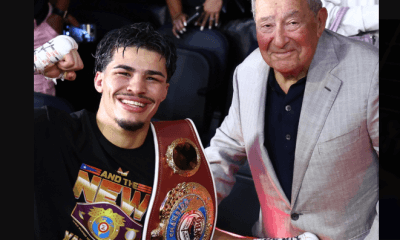
 Featured Articles4 weeks ago
Featured Articles4 weeks agoThe Hauser Report: Zayas-Garcia, Pacquiao, Usyk, and the NYSAC
-
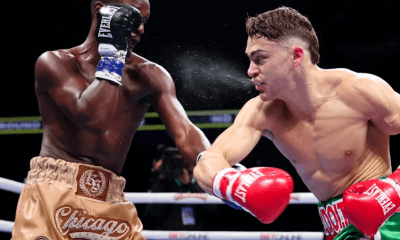
 Featured Articles3 weeks ago
Featured Articles3 weeks agoOscar Duarte and Regis Prograis Prevail on an Action-Packed Fight Card in Chicago
-
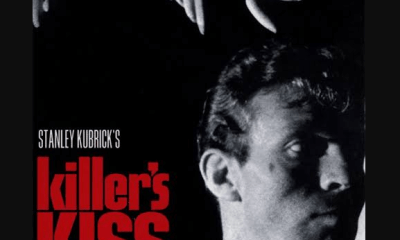
 Featured Articles2 weeks ago
Featured Articles2 weeks agoThe Hauser Report: Cinematic and Literary Notes
-
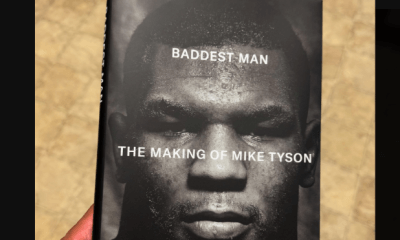
 Book Review2 weeks ago
Book Review2 weeks agoMark Kriegel’s New Book About Mike Tyson is a Must-Read
-

 Featured Articles4 weeks ago
Featured Articles4 weeks agoRemembering Dwight Muhammad Qawi (1953-2025) and his Triumphant Return to Prison
-
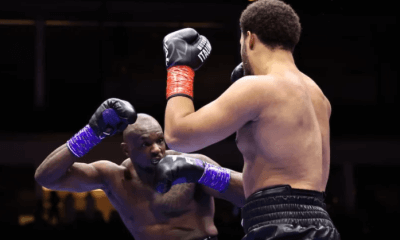
 Featured Articles6 days ago
Featured Articles6 days agoMoses Itauma Continues his Rapid Rise; Steamrolls Dillian Whyte in Riyadh
-
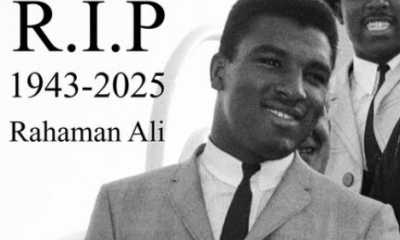
 Featured Articles3 weeks ago
Featured Articles3 weeks agoRahaman Ali (1943-2025)
-

 Featured Articles3 weeks ago
Featured Articles3 weeks agoTop Rank Boxing is in Limbo, but that Hasn’t Benched Robert Garcia’s Up-and-Comers




